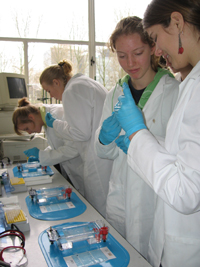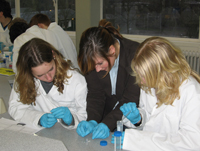DNA labs on the road Teach article
Ever wished you could borrow a PCR machine for your lessons? And perhaps an expert to show your students how to use it? Marc van Mil introduces DNA labs that bring genomics directly to the classroom.

Gerrianne and Marianne, biomedical students at Utrecht University, the Netherlands, are getting ready to leave for Amsterdam. They have just packed their vehicle with a PCR machine, gel-electrophoresis equipment and all the materials necessary to turn a classroom into a real DNA laboratory. The pupils of the St. Nicolaaslyceum in Amsterdam are excited. A few days ago, they started the module ‘Read the language of the tumour’ with an introduction to DNA and cancer. Today, during the practical part of the module, they will be real DNA researchers and compare DNA from cancer cells of a (fictitious) patient with DNA of healthy cells. Based on their lab results, they must then advise a physician on the optimal treatment of this particular patient. This may seem like science fiction but it is business as usual in the Netherlands. Every weekday, university students travel in vans loaded with lab materials to secondary schools throughout the country to teach the latest in genomics research.
Mobile DNA labs

to compare genes in healthy
cells and tumour cells
Image courtesy of Marc van Mil
The DNA lab ‘Read the language of the tumour’ is one of five mobile DNA labs travelling through the Netherlands. Five Genomics Centres of Excellence from the Netherlands Genomics Initiativew1 each developed a mobile DNA lab; they have been offered free of charge to all secondary schools in the Netherlands since January 2006. The four-hour educational modules for secondary-school pupils (ages 16-18) include a two-hour practical lab taught at school by university students with up-to-date genomics equipment and techniques. Teacher and pupil manuals are specifically developed for each lab and provided in advance so as to optimise the learning experience. Teachers can obtain additional information and register for the labs on the DNA lab websitew2.
The university students bring all the equipment, from pipettes to PCR machines and even a fluorescent microscope. They turn the classroom into a real genomics laboratory.
The experiments in the five DNA labs differ, but in all cases the pupils perform the real hands-on laboratory activities in their own classroom. They isolate DNA and use the PCR technique to analyse it, culture yeast in different conditions to measure the production of ethanol, crystallise proteins and use bioinformatics tools to look at protein structures.
DNA research in context
The five DNA labs deal with different topics in the life sciences: from producing bio-fuels to plant breeding, from using bioinformatics in crime-scene investigations to improving the treatment of diseases like Alzheimer’s and cancer. Although these subjects may appear to be very different, they all rely on genomics research. More importantly, the DNA labs provide a context in which new insights in genomics are used to solve everyday problems. For instance, to increase the number of people who survive cancer, we need to know about specific mutations in DNA that turn healthy cells into cancer cells.
Developing the DNA labs
Developing the DNA labs was an initiative of the genomics research centres in the Netherlands. Within these centres, state-of-the-art knowledge about current genomics research is easily accessible. However, a good module for high-school pupils requires more than just the latest insights in research. Success of the DNA labs has depended on a close collaboration with high-school teachers and education professionals during development and testing.
In current science education, there is the belief that teaching science concepts using contexts makes them more meaningful, i.e. starting from science applications and implications in different practices, which in turn can empower consumers, patients and citizens of a democratic society. The DNA labs were developed in line with the recommendations of the Committee for Innovation in Biology Education on context-concept approach. In the Dutch high-school curriculum, DNA is an important yet rather isolated topic that pupils often perceive as complex and highly abstract. By teaching DNA within a meaningful context as a starting point, it becomes very clear why learning about this subject is so important.
University students

needed for DNA analysis
Image courtesy of Marc van Mil
University undergraduate students play an essential role in this project. They are the ones who go into schools to teach the practical part of the module, serve as ‘ambassadors’ for science and provoke all sorts of questions from pupils about working in science and studying it at university. They thus serve as young and inspiring role models. For the undergraduates, this is a challenging job since it is often the first time they are actively involved in science communication and education. This experience provides them with the basic communication skills essential for all scientists and equips them with the tools to inform the general public about their work in a meaningful way. By teaching the DNA lab, students realise that teaching is not easy, but it is a very inspiring task.
Before their first school visit, the students receive three days of intensive training. They are not only trained in didactic skills and dealing with a classroom full of pupils, but also taught to consider the role of scientists in genomics education and communication.
Evaluation of the DNA labs
The goal of the DNA labs is to offer relevant and up-to-date genomics education in the Netherlands, based on new insights in didactics. After more than a year of running the mobile DNA labs, we can now conclude that they are a great success. Pupils, teachers and university students are very enthusiastic. By July 2007, the heavily booked labs will have reached over 25 000 pupils in 275 different schools in the Netherlands. Furthermore, an independent evaluation has shown that the DNA labs promote understanding of the possibilities that genomics research offers for society and that they stimulate a positive attitude towards genomics.
For the students at genomics centres, the DNA labs are their favourite outreach activity. For teachers, DNA labs offer a unique opportunity to get modern equipment and the latest scientific insights into their schools. For the pupils, it is a very motivating and fun way of learning. International peer-review committees of the genomics centres have commented very positively on the DNA lab initiative and have recommended expanding it to other European countries.
The DNA lab organisers hope to work with other interested research institutes in Europe to develop an international platform for sharing experiences and improving education projects. Ultimately, the goal is to incorporate new insights into DNA research in the regular high-school curriculum. Schools should not have to depend on projects like these to gain access to new developments in science; they should be part of the curriculum. Research centres could help to use the latest insights to update the curriculum and have an important role in opening their doors to schools and sharing their discoveries and new developments in science. The mobile DNA labs are a good example of how this task can be achieved through a collaboration between all relevant parties. Scientists in research institutes have the knowledge, while high-school teachers and education professionals have the experience to develop meaningful education and teach in a way that suits high-school students. The DNA labs show that if these professionals work together, science education can be innovative, challenging and exciting.
The practicalities
Setting up the mobile DNA labs cost a lot of money. The power of the project is that the equipment the university students bring into the school is usually not available in a secondary school. The equipment for the mobile DNA labs costs several thousand Euros, but it is used in more than 100 different schools per year. If you wanted to set up a similar project at a lower cost, you could perhaps use old materials that are no longer needed.
Taking the equipment to the schools requires not only a van, but also good contacts with the schools and good logistics. However, the alternative of inviting pupils to the research centres is less effective. By going to the schools, the DNA labs can reach students all over the Netherlands (admittedly a rather small country) and teachers do not have to arrange transportation and a whole day off for their pupils. This makes the DNA labs a very accessible activity.
A further cost is the money paid to the undergraduates involved. An alternative, however, would be to incorporate the DNA lab activities into the university curriculum, as part of a science communication course.
After an hour and a half of hard work, the pupils in Amsterdam examine the results of their DNA analysis. In the next lesson they will reflect on their results and write to the physician with advice regarding the optimal treatment of the patient. After packing up the lab, Marianne and Gerrianne take a look at the notes the pupils left behind. Comments range from “Interesting!” to “Great fun!” and “Fascinating!”. Satisfied, they load the van to return to Utrecht, ready to prepare for another day of DNA labs on the road.
Web References
- w1 – The website of the Netherlands Genomics Initiative.
- w2 – English version of the DNA labs website.
- w3 – The website of the Cancer Genomics Centre.
Resources
- For more information on genomics for high-school students (in Dutch), see: www.watisgenomics.nl





